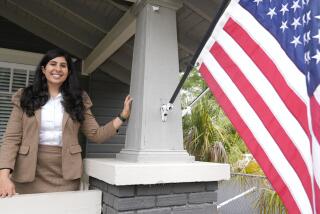1930 Census Forms Give a Snapshot of History
- Share via
WASHINGTON — June Hall moved her finger down the page, found her grandmother’s name and smiled.
After half an hour of scrolling through microfilm of personal records from the 1930 census, Hall had hit pay dirt: the line that showed her grandmother’s house, the home in which Hall was born.
Hall joined dozens of people Monday at the National Archives looking to fill in the blanks of their family histories as privacy protection for individual 1930 census records expired. The expiration, 72 years after each census, allows people to see information beyond the dry statistics typically available after the once-a-decade count.
“It’s a real high. You get into this and you just get hooked,” said Hall, of Baltimore. Although Hall had not been born by 1930, she read that her grandmother lived on what was then a dirt road and her father worked as a salesman and lived with her grandparents.
Historians billed it as the largest release of such personal records by the federal government, providing a gold mine of genealogical data.
“We get a picture more revealing than any previous census,” John Carlin, archivist of the United States, said before cutting the ribbon to the dimly lighted census research room. “The census is still the most complete record we have in our country at any single point in time.”
Historians said the records would provide a more detailed look at life in America at the dawn of the Great Depression. The 1930 census date of April 1 came about five months after the October 1929 stock market crash.
All Americans answered the same 32 questions, including: What is your name? How old are you? Where were you born?
Some questions typified the times, including: “Does this household have a radio set?”
No forms were mailed. Census takers visited homes and recorded the answers on a large answer grid that looked like a giant school report card.
Original 1930 forms have been destroyed, but copies were put on 2,667 rolls of microfilm in the 1940s. Those copies were made available at archive headquarters in Washington and at 13 other archive offices around the country, including Laguna Niguel in Southern California and San Bruno in Northern California.
Some of the handwritten forms were easy to read. The form for the White House in 1930, for instance listed Herbert Hoover as “head of household.” Occupation? “President of the United States.”
*
On the Net:
National Archives’ 1930 census:
https://https://1930census.archives.gov/
Census Bureau:
https://https://www.census.gov/
More to Read
Sign up for Essential California
The most important California stories and recommendations in your inbox every morning.
You may occasionally receive promotional content from the Los Angeles Times.













